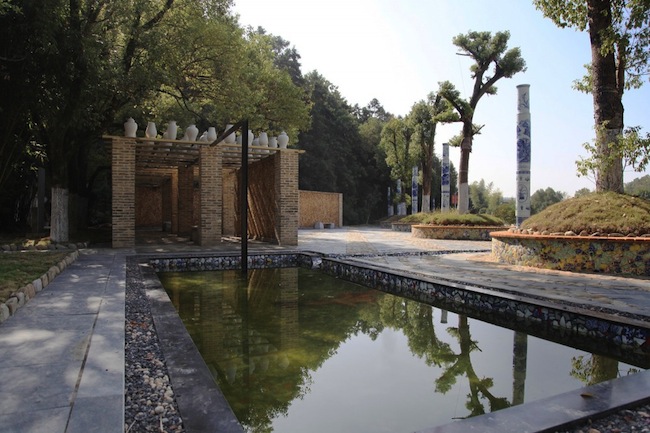The city of Jingdezhen, which is located in the lower, central part of China, is known as the “Porcelain Capital” because it has been producing high quality porcelain since the Han Dynasty (206 BC – 220 AD). Recently, there has been renewed interest in preserving and building upon this history, ceramists who studied there are now more likely to stay and other ceramic artists have been drawn to the scene. Ceramic markets have proliferated and they have become a national and international draw for tourists and collectors. No doubt, it was this renaissance that prompted a redevelopment of the Porcelain Culture Park in Jingdezhen, which went to the Chinese architects, Tongheshanzhi Landscape Design Co.
According to an article on ArchDaily, which was a statement by Tongheshanzhi Landscape Design Co., the park still had along way to go before becoming a true national attraction, although it had been built for several years. The designer’s biggest dilemma was how to promote “porcelain culture” yet at the same time complement the function of the park.
TLD Co.’s initial impressions were that the craft on display and the traditional kilns were outstanding, but the park was outmoded for modern tourism and lacking interactivity. They thought it could be better presented in a contemporary fashion, so they transformed the old, traditional park by using local material and modern techniques.
A series of “frame” display windows were designed to separate vehicles and pedestrians, which also improved the view of the entrance. Fragments of porcelain massy were used as part of the structure. Tongheshanzhi Landscape Design Co designed the fence facing the main street of Jingdezhen to resemble the elevation of traditional kiln building, with the height dependent on the terrain. All of the materials in the construction of the park are common in local building practices, such as porcelain and kiln fired bricks.
We here at CFile find the project to be somewhat muddled; the individual materials are attractive but they seem unwilling to work together. The overall effect is busy rather than harmonious. Perhaps we are too enamored with the Chinese architect Wang Shu’s approach to building with found ceramic material (you can find links to Garth Clark’s posts about Wang’s Ceramic House and Ningbo Museum below). His use of wa pan, a traditional Chinese building technique that combines existing ceramic materials (often from different eras), is flawlessly integrated into his buildings in a way that makes them stunning, uniquely contemporary, and deeply connected to the past. But this comparison is unfair. Not only is Tongheshanzhi Landscape Design Co.’s project a renovation, with all the restraints that come with working with existing structures, it had a seemingly impossible mandate: to represent over 2,000 years of ceramic history. Despite our aesthetic reservations, the park is a celebration of “porcelain culture,” and that we support wholeheartedly.
Above image: Tongheshanzhi Landscape Design Co.’s renovation of the Porcelain Culture Park in Jingdezhen, China. Courtesy of the architects.







The Porcelain Culture Park in Jingdezhen, China. All images courtesy of Tongheshanzhi Landscape Design Co.
Read the architect’s full description of the project at ArchDaily
See Garth Clark’s post on Wang Shu’s Ningbo Museum
See Garth Clark’s post on Wang Shu’s Ceramic House

Add your valued opinion to this post.